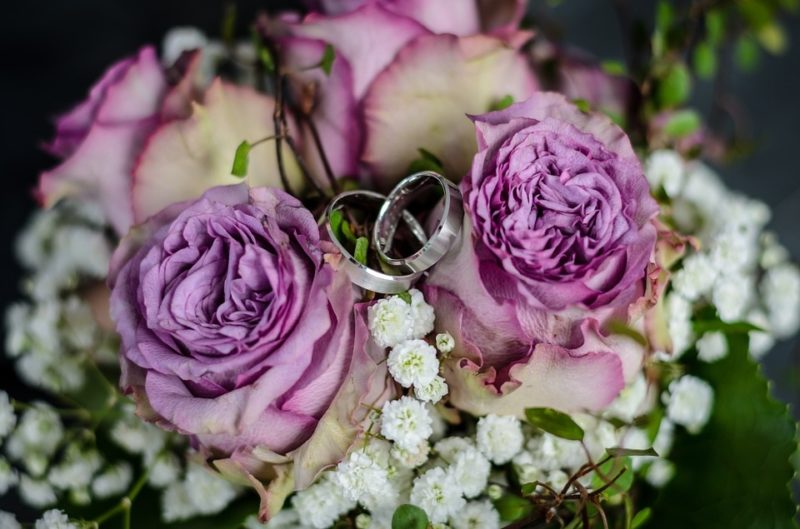If you want to know how to make a cascading wedding bouquet, consider simplifying the process into three steps. First, this article will teach you the preparation for the bouquet holder up to the arrangement of the flowers to get the signature trailing look when the bride holds it.
We also recommend browsing our blog for other bouquet tutorials to know more tips. Perhaps you’re also looking to learn how to make a wedding bouquet with a bouquet holder instead of hiring a florist.

How To Make A Cascading Wedding Bouquet At Home
Step 1. Prepare the bouquet holder
- Only make the wedding bouquet a day before the wedding; consider using tough flowers or include some fake ones if the bouquet will be done earlier
- Soak the foam portion of the bouquet holder in warm water to prepare it for arrangement
- You can also mix flower food into the water according to instructions as it can help the flowers last longer
- Simply have the bouquet holder under the container of warm water without pushing it down that it will form air bubbles, which is bad for bouquets since they’ll keep the flowers from getting hydrated
- Lift the bouquet holder off the water after a minute and turn it right side up
- Place the bouquet holder in a vase, ideally something heavy to keep it from tipping over once you start arranging the flowers
Step 2. Arrange the bouquet
- Have the longest greenery stems at the front of the bouquet holder by pushing their tips down into the foam
- Continue adding more greenery until you have enough volume to achieve your desired look of the wedding bouquet
- Do not be afraid to use many greenery stems because a cascading wedding bouquet looks like the arrangement is spilling around your hand when you hold them
- Cut the stems if needed to ensure that those at the top remains shorter than the bottom because it will be hard to hold the bouquet if it’s the opposite
- Cut the thick stems at an angle to make their insertion easier
- Check if the bouquet looks symmetrical and add greenery at the top and sides as needed
- Imagine a raindrop shape when arranging the plants because you want them fuller at the top and sides but narrower at the bottom
- Once you have arranged the base of greenery on the bouquet holder, start adding the flowers with the largest and primary ones at the center
- Use the other flowers all around the bouquet holder to add colors and variety
- Continue the raindrop shape of the bouquet so that it will be cascading; the top flowers are straight, the ones around them are more horizontal, and the longest stems are pointing downward
- Arrange the flowers, so their stems interlock and secure them inside the bouquet
- If there are flowers with soft stems, secure the bloom with a pin and wrap the stem with wire and floral tape
- Lastly, make sure that the flowers are equally distributed to create a trailing look
Step 3. Finish the bouquet
- After adding the main flowers, make the necessary trimmings on the stems to create a shape where the ones on top are shorter, and the ones on the bottom are longer
- Cut stems one at a time and check the shape of the cascading wedding bouquet to avoid excessive trimming
- Alternate accent flowers at the top and sides of the bouquet to help make it look fuller
- Use greenery or baby’s breath to fill empty spaces on the bouquet; you can also use these fillers to strengthen the grid of stems and prevent the flowers from falling
- Put the finished cascading wedding bouquet in a floral cooler or any place out of direct sunlight and heat, but never in the refrigerator that can cause it to wilt due to excess moisture
How Do You Wire A Cascading Bouquet?
- Select blooms of your choice and wrap their bottom stems with wet cotton
- Use flowers with artificial leaf backing and puncture the stem beneath it halfway with floral wire
- Bend the wire to hold the cotton in step one and wrap both the stem and wire with floral tape
- After wiring and taping all the blooms, fold the artificial leaves back and cut them off, so only their bases remain
- For the rest of the cascading bouquet, prepare a bunch of ivy and foliage of your choice by snipping their leaves
- Attach a piece of florist wire with floral tape to them and create enough foliage for every bloom
- Create a spine for the trailing bouquet by taking two pieces of florist wire and taping them together
- Attach the foliage you just made to the spine using floral tape
- Alternate the arrangement with the blooms to secure them in place
- Once only about 7 inches of the spine remains, secure the bouquet with tape
- Create a nosegay with the foliage stems by wrapping them with floral tape, then bend the stem of the trailing portion
- Place the bent stem next to the nosegay and secure them together with floral tape to form a single bouquet
- Wrap with ribbon to finish
Conclusion
That’s it! You’ve just learned how to make a cascading wedding bouquet starting with soaking the holder then arranging everything similar to a raindrop shape.
The secret is creating a grid pattern when inserting the stems to secure the arrangement. Feel free to check our tutorials for other wedding flowers, such as how to make wedding corsages.
